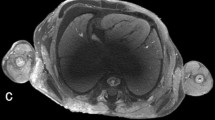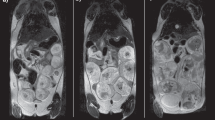Abstract
Objectives
The purpose of our study was to evaluate MRI as a tool to examine placental morphology in a murine model in comparison to classical histology techniques.
Methods
Assessment of placental samples (n = 24) from C57Bl/6 J mice was performed using MR imaging and histomorphological analyses. To optimize image contrast for MRI, a protocol for gadolinium-mediated enhancement of placental tissue was established. To test method sensitivity, placental zone assessment with MRI and histology was applied to a model of prenatal stress exposure known to affect placental morphology (n = 10). Mean data acquisition time for both methods was estimated. Difference between groups was calculated using the Mann–Whitney U test.
Results
Tissue fixation with formaldehyde and staining with gadolinium resulted in the best image quality. Placental functional zones were identified and measured with both MRI and histology. MRI and histology were able to detect changes in the L/Jz ratio upon a prenatal stress challenge (p = 0.001; p = 0.003). Data acquisition time was shorter using MRI assessment.
Conclusions
Ex vivo MRI analyses of murine placental functional morphology with MRI are feasible and results are comparable to time-consuming histology. Both MRI and histology allow the detection of experimentally induced morphological tissue alterations.






Similar content being viewed by others
References
Zamyadi M, Baghdadi L, Lerch JP et al (2010) Mouse embryonic phenotyping by morphometric analysis of MR images. Physiol Genomics 42A:89–95
Coan PM, Vaughan OR, Sekita Y et al (2010) Adaptations in placental phenotype support fetal growth during undernutrition of pregnant mice. J Physiol (Lond). 588:527–538
Huang S, Liu C, Dai G, Kim YR, Rosen BR (2009) Manipulation of tissue contrast using contrast agents for enhanced MR microscopy in ex vivo mouse brain. NeuroImage. 46:589–599
Dokras A, Hoffmann DS, Eastvold JS et al (2006) Severe feto-placental abnormalities precede the onset of hypertension and proteinuria in a mouse model of preeclampsia. Biol Reprod 75:899–907
Petiet A, Johnson GA (2010) Active staining of mouse embryos for magnetic resonance microscopy. Methods Mol Biol 611:141–149
Bersu ET, Mossman HW, Kornguth SE (1989) Altered placental morphology associated with murine trisomy 16 and murine trisomy 19. Teratology. 40:513–523
Parasoglou P, Berrios-Otero CA, Nieman BJ, Turnbull DH. High-resolution MRI of early-stage mouse embryos. NMR Biomed. 2012
Redline RW, Lu CY (1989) Localization of fetal major histocompatibility complex antigens and maternal leukocytes in murine placenta. Implications for maternal-fetal immunological relationship. Lab Invest 61:27–36
Robertson SA (2004) Effect of 2-glycoprotein I null mutation on reproductive outcome and antiphospholipid antibody-mediated pregnancy pathology in mice. Mol Hum Reprod 10:409–416
Georgiades P, Ferguson-Smith AC, Burton GJ (2002) Comparative developmental anatomy of the murine and human definitive placentae. Placenta 23:3–19
Guillemot F, Nagy A, Auerbach A, Rossant J, Joyner AL (1994) Essential role of Mash-2 in extraembryonic development. Nature 371:333–336
Benveniste H, Kim K, Zhang L, Johnson GA (2000) Magnetic resonance microscopy of the C57BL mouse brain. NeuroImage. 11:601–611
Johnson GA, Cofer GP, Fubara B, Gewalt SL, Hedlund LW, Maronpot RR (2002) Magnetic resonance histology for morphologic phenotyping. J Magn Reson Imaging 16:423–429
Cyr M, Caron MG, Johnson GA, Laakso A (2005) Magnetic resonance imaging at microscopic resolution reveals subtle morphological changes in a mouse model of dopaminergic hyperfunction. NeuroImage. 26:83–90
Dhenain M, Delatour B, Walczak C, Volk A (2006) Passive staining: a novel ex vivo MRI protocol to detect amyloid deposits in mouse models of Alzheimer’s disease. Magn Reson Med 55:687–693
Johnson GA, Cofer GP, Gewalt SL, Hedlund LW (2002) Morphologic phenotyping with MR microscopy: the visible mouse. Radiology 222:789–793
Acknowledgements
Financial support was provided within the Network of Feto-Maternal Cross Talk, funded by the Excellence Initiative of the Hamburg Foundation for Research, and the German Research Foundation.
Author information
Authors and Affiliations
Corresponding author
Ethics declarations
Conflict of interest
The authors declare that they have no conflict of interest.
Ethical standards
Ethical approval for all procedures involving animals was obtained from the local ethical committee.
Rights and permissions
About this article
Cite this article
Remus, C.C., Solano, E., Ernst, T. et al. Comparative analysis of high field MRI and histology for ex vivo whole organ imaging: assessment of placental functional morphology in a murine model. Magn Reson Mater Phy 32, 197–204 (2019). https://doi.org/10.1007/s10334-018-0708-6
Received:
Revised:
Accepted:
Published:
Issue Date:
DOI: https://doi.org/10.1007/s10334-018-0708-6




